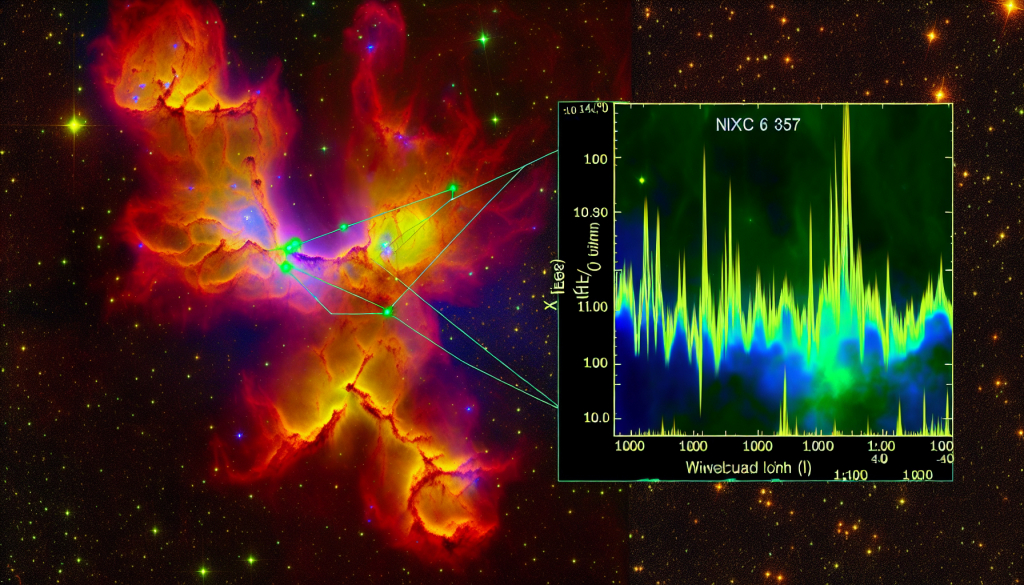Young star's carbon dioxide-heavy disk discovery questions current planet formation theories

Image:
An image shows the NGC 6357 star-forming region, featuring a young star known as XUE 10. Data from the JWST/MIRI instrument identifies a disk forming planets, notable for its distinct lack of water but an abundance of carbon dioxide — including four chemical variations of the molecule. This discovery sheds light on the chemical setting in which new planets begin to form. Photo credit: Stockholm University and María Claudia Ramírez-Tannus, Max Planck Institute for Astronomy.
Credit: Stockholm University and María Claudia Ramírez-Tannus, Max Planck Institute for Astronomy
A new investigation led by Jenny Frediani at Stockholm University has identified a planet-forming disk with a surprisingly high level of carbon dioxide (CO₂), especially in areas where Earth-like worlds might someday emerge. This finding, made using the James Webb Space Telescope (JWST), presents a contrast to what has commonly been expected regarding the chemical makeup of such regions. The findings appear in the journal Astronomy & Astrophysics.
"In many similar disks, water vapor tends to be the most prominent feature in the inner regions," says Jenny Frediani, a Ph.D. researcher at Stockholm University’s Department of Astronomy. "But in this case, we found carbon dioxide far more abundant, while water is nearly undetectable — it's a striking difference from the norm."
When a star initially forms, it remains enshrouded by the gas from which it was born. Around it, material creates a rotating disk, eventually leading to planet formation. Typical planet-formation models suggest that icy particles travel from the chilly outer regions of the disk inward, where rising heat turns the ice into vapor — usually resulting in observable traces of water in the warmer zones. However, analysis using JWST/MIRI has instead revealed an unusually strong carbon dioxide presence here.
"This unusual ratio between CO₂ and water pushes us to rethink the currently accepted models for how these disks evolve over time," explains Frediani.
Arjan Bik, an astronomy researcher at Stockholm University, adds, "Such a large amount of carbon dioxide in the central planet-forming area is unexpected. It suggests that high-energy ultraviolet radiation, perhaps from the star itself or surrounding massive stars, may be altering the disk’s chemistry."
The study also unveiled the presence of rare carbon dioxide isotopologues — versions of the molecule containing either carbon-13 or uncommon forms of oxygen like ¹⁷O and ¹⁸O. These results, readily visible in the JWST data, may offer insights into long-standing mysteries about the chemical fingerprints seen in Solar System materials such as meteorites and comets.
This carbon dioxide-rich disk is situated in NGC 6357, a vast region of star formation located around 1.7 kiloparsecs (approximately 53 trillion kilometers) from Earth. The discovery is part of research carried out by the XUE project (eXtreme Ultraviolet Environments), which explores how strong radiation affects the chemical makeup of these disks.
According to María Claudia Ramírez-Tannus of the Max Planck Institute for Astronomy, who leads the XUE project, this is a ground-breaking observation: "It underscores how intense radiation, common in large star-forming areas, can reshape the very materials from which planets are assembled. Since most stars — and by extension, most planets — form in such regions, this understanding is crucial for exploring the diversity and potential habitability of exoplanet atmospheres."
With the capabilities of JWST’s MIRI instrument, astronomers can now peer through dense cosmic dust to observe these planet-forming zones in the infrared spectrum with remarkable precision. This enables a broader understanding of the various environments in which planetary systems come to life. Scientists from Stockholm University and Chalmers were instrumental in the development of MIRI — an advanced infrared camera and spectrograph that works at wavelengths from 5 to 28 microns and includes instruments designed especially for studying exoplanets.
The research is detailed in the article titled “XUE: The CO₂-rich terrestrial planet-forming region of an externally irradiated Herbig disk,” published in Astronomy & Astrophysics.
Journal
Astronomy & Astrophysics
DOI
10.1051/0004-6361/202555718
Method of Research
Observational study
Subject of Research
Not applicable
Article Title
XUE: The CO₂-rich terrestrial planet-forming region of an externally irradiated Herbig disk
Article Publication Date
29-Aug-2025